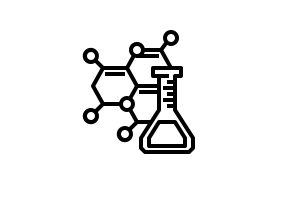Rhenium(I) trinuclear rings as highly efficient redox photosensitizers for photocatalytic CO2 reduction: Difference between revisions
 publication
publication
| About |
|---|
content |
m auto-generated |
||
| Line 3: | Line 3: | ||
===Abstract=== | ===Abstract=== | ||
==== Summary==== | ==== Summary==== | ||
A photochemical reduction of CO<sub>2</sub> to CO or formic acid was shown using the bipyridine-based rhenium, ruthenium and manganese catalysts {{#moleculelink:|link=NZCMNMSVXYOMGS-UHFFFAOYSA-N|image=false|width=300|height=200}}, {{#moleculelink:|link=XUQJAKJUMNDNTK-UHFFFAOYSA-L|image=false|width=300|height=200}} or {{#moleculelink:|link=WCQGNVNGTWFVLO-UHFFFAOYSA-N|image=false|width=300|height=200}} in combination with cyclic rhenium-based trinuclear redox photosensitizers. Turnover numbers (TONs) of up to 290 for formic acid were reached in DMA with the ruthenium complex {{#moleculelink:|link=XUQJAKJUMNDNTK-UHFFFAOYSA-L|image=false|width=300|height=200}} and photosensitizer {{#moleculelink:|link=KSOIVZAANOLODS-UHFFFAOYSA-T|image=false|width=300|height=200}}. For CO production, TONs of up to 98 were obtained in DMF with the rhenium complex {{#moleculelink:|link=NZCMNMSVXYOMGS-UHFFFAOYSA-N|image=false|width=300|height=200}} and photosensitizer {{#moleculelink:|link=LOLRMPNEYKEGPF-UHFFFAOYSA-T|image=false|width=300|height=200}}. The experiments were conducted under visible-light irradiation (λ = 436 nm) using TEOA as sacrificial electron donor (see section SEDs below). | A photochemical reduction of CO<sub>2</sub> to CO or formic acid was shown using the bipyridine-based rhenium, ruthenium and manganese catalysts {{#moleculelink:|link=NZCMNMSVXYOMGS-UHFFFAOYSA-N|image=false|width=300|height=200}}, {{#moleculelink:|link=XUQJAKJUMNDNTK-UHFFFAOYSA-L|image=false|width=300|height=200}} or {{#moleculelink: |link=WCQGNVNGTWFVLO-UHFFFAOYSA-N|image=false|width=300|height=200}} in combination with cyclic rhenium-based trinuclear redox photosensitizers. Turnover numbers (TONs) of up to 290 for formic acid were reached in DMA with the ruthenium complex {{#moleculelink:|link=XUQJAKJUMNDNTK-UHFFFAOYSA-L|image=false|width=300|height=200}} and photosensitizer {{#moleculelink:|link=KSOIVZAANOLODS-UHFFFAOYSA-T|image=false|width=300|height=200}}. For CO production, TONs of up to 98 were obtained in DMF with the rhenium complex {{#moleculelink:|link=NZCMNMSVXYOMGS-UHFFFAOYSA-N|image=false|width=300|height=200}} and photosensitizer {{#moleculelink:|link=LOLRMPNEYKEGPF-UHFFFAOYSA-T|image=false|width=300|height=200}}. The experiments were conducted under visible-light irradiation (λ = 436 nm) using TEOA as sacrificial electron donor (see section SEDs below). | ||
====Advances and special progress==== | ====Advances and special progress==== | ||
Re(I)-based trinuclear photosensitizers were developed and allowed for high product selectivities for CO or formic acid in CO<sub>2</sub> reduction attempts with different bipyridine-based catalysts. | Re(I)-based trinuclear photosensitizers were developed and allowed for high product selectivities for CO or formic acid in CO<sub>2</sub> reduction attempts with different bipyridine-based catalysts. | ||
Revision as of 10:50, 23 January 2024
|
A molecule on this page has a mistake in its structure or is missing a part. Please edit the structure or redraw a new molecule using the replace molecule workflow.
|
|
This page about a publication or dataset does not currently include an investigation. Please add any experiments detailed in the publication or performed to obtain this dataset.
|
Abstract
Summary
A photochemical reduction of CO2 to CO or formic acid was shown using the bipyridine-based rhenium, ruthenium and manganese catalysts [Re(bpy)(CO)3(MeCN)][PF6], Ru(dtBubpy)(CO)2Cl2 or Molecule with key WCQGNVNGTWFVLO-UHFFFAOYSA-N does not exist. in combination with cyclic rhenium-based trinuclear redox photosensitizers. Turnover numbers (TONs) of up to 290 for formic acid were reached in DMA with the ruthenium complex Ru(dtBubpy)(CO)2Cl2 and photosensitizer Molecule with key KSOIVZAANOLODS-UHFFFAOYSA-T does not exist.. For CO production, TONs of up to 98 were obtained in DMF with the rhenium complex [Re(bpy)(CO)3(MeCN)][PF6] and photosensitizer Molecule with key LOLRMPNEYKEGPF-UHFFFAOYSA-T does not exist.. The experiments were conducted under visible-light irradiation (λ = 436 nm) using TEOA as sacrificial electron donor (see section SEDs below).
Advances and special progress
Re(I)-based trinuclear photosensitizers were developed and allowed for high product selectivities for CO or formic acid in CO2 reduction attempts with different bipyridine-based catalysts.
Additional remarks
Content of the published article in detail
The article contains results for the reduction of CO2 to CO or formic acid under visible-light catalysis using bipyridine-based complexes and rhenium-based trinuclear rings as photosensitizers. The catalytic system performs best (referring to the TON of formate production) in DMA and in DMF for CO production.
Catalyst
[Re(bpy)(CO)3(MeCN)][PF6]
Ru(dtBubpy)(CO)2Cl2

Photosensitizer

Investigation
| cat | cat conc [µM] | PS | PS conc [mM] | solvent A | . | . | λexc [nm] | . | TON CO | . | . | . | |
|---|---|---|---|---|---|---|---|---|---|---|---|---|---|
| 1. | 50 | 0.05 | 436 | 27 | |||||||||
| 2. | 50 | 0.05 | 436 | 98 | |||||||||
| 3. | 50 | 0.05 | 436 | 22 | |||||||||
| 4. | 50 | 0.05 | 436 | 71 | |||||||||
| 5. | 0.05 | 436 | 6 | ||||||||||
| 6. | 0.05 | 436 | 8 | ||||||||||
| 7. | 50 | 0.05 | 436 | 20 | |||||||||
| 8. | 50 | 0.05 | 436 | 32 | |||||||||
| 9. | 50 | 0.05 | 436 | 11 | |||||||||
| 10. | 50 | 0.05 | 436 | 48 |

| cat | cat conc [µM] | PS | PS conc [mM] | e-D | e-D conc [M] | solvent A | . | . | λexc [nm] | . | TON CO | TON H2 | TON HCOOH | . | . | . | |
|---|---|---|---|---|---|---|---|---|---|---|---|---|---|---|---|---|---|
| 1. | 50 | 0.05 | 436 | 20 | 72 | 290 | |||||||||||
| 2. | 50 | 0.05 | 0.03 | 436 | 16 | 49 | 280 | ||||||||||
| 3. | 50 | 0.05 | 436 | 32 | 85 | ||||||||||||
| 4. | 50 | 0.05 | 0.03 | 436 | 80 | 60 |

Sacrificial Electron Donor
In this study, the experiments were done with the sacrificial electron donor TEOA (100507).
Additives
In this study, no additives were tested.

